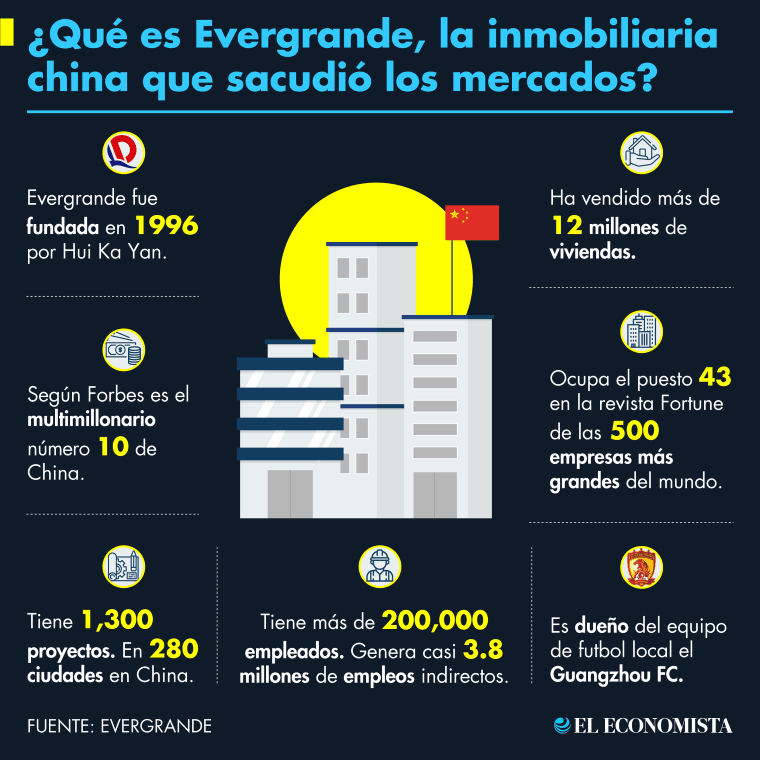The Chinese real estate sector suffered a new shock this Tuesday, after Kaisa Group made a desperate request for help and that the Federal Reserve The United States sent its first direct warning that the crisis could cause global damage.
Builders’ bonds fell again after sources in China said Kaisa, which was the first of its promoters to default in 2015, had said in a meeting with a group of experts from the government and some of the country’s banks and real estate companies that it needed help paying creditors, workers and suppliers.
Bonds of other large companies also plummeted, and those of R&F Properties and China Vanke -considered one of the strongest companies in the sector- recorded their biggest drops.
The outbreak occurred just hours after the Federal Reserve it warned that the problems could pose a global risk.
“Given the size of China’s economy and financial system … financial stress in China could strain global financial markets, through a deterioration in risk appetite, and pose risks to global growth,” he said the Fed in its financial stability report.
The liquidity shortage was highlighted by Fitch, that downgraded Kaisa’s rating on Tuesday even approaching default, citing deteriorating finances, difficulties selling assets, and undeclared debt from its wealth management unit.
“We sincerely ask investors to give Kaisa more time and patience,” he said in a statement on his official WeChat messaging app account on Monday.
Begging for help
Kaisa is the 25th promoter in China by sales, but only Evergrande, the symbol of the real estate crisis in the country, has to pay more debt for bonds next year.
In the morning, Kaisa attended a meeting with an expert group from China’s powerful State Council with real estate developers and banks in the city of Shenzhen, a well-positioned source told Reuters.
Although the think tank makes policy proposals on China’s national development and its economy, it is not a decision-making body.
In the meeting with the Development Research Center of the State Council, Kaisawhich is based in Shenzhen, state-owned companies were urged to help private companies improve their liquidity by acquiring projects and strategic purchases, the source said.
Other participants in the meeting included China Vanke, Ping An Bank, China Citic Bank, China Construction Bank and CR Trust, according to the source.
The developer said that some financial institutions had improperly transferred funds from their account and urged that all lawsuits seeking freezing of their assets be processed centrally in a Shenzhen court.
Vanke, Kaisa and Citic Bank they declined to comment. Excellence and the other banks that participated in the meeting did not immediately respond to requests for comment.
The Information Office of the State Council also did not respond to a request for comment. The source declined to be identified due to the sensitivity of the matter.

Upcoming deadlines
The problems in the Chinese real estate sector have unsettled global markets and prompted a string of authorities in Beijing to try to calm things down, ensuring that the debt crisis will not spiral out of control.
The indebted promoter China Evergrande Group It has rocked global markets as it grapples with liabilities of more than $ 300 billion, which, if left unmanaged, could create systemic risks for the Chinese financial system.
Beijing is spurring state-owned companies and developers with government backing to buy some of its assets. Evergrandesources with knowledge of the matter previously told Reuters.
Twice in October, Evergrande narrowly avoided catastrophic defaults on its $ 19 billion in international capital markets by paying off coupons just before its grace periods expired.
One of these periods expires on Wednesday, November 10, for more than $ 148 million in coupon payments that were due on October 11. Evergrande You must also make coupon payments totaling more than $ 255 million on your June 2023 and 2025 bonds on December 28.
Reference-www.eleconomista.com.mx